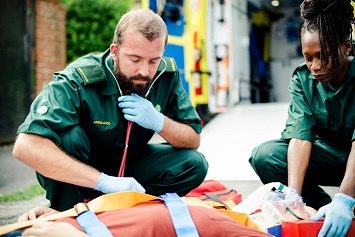AIHA (formerly the American Industrial Hygiene Association) launched a new website—https://www.workerhealthsafety.org/first-responders—with occupational health resources about the long-term health risks faced by emergency responders. The website includes a case study of training to prepare first responders for rail emergencies and a directory of industrial hygienists and occupational and environmental health and safety (OEHS) professionals.
The uncontrolled work environments in which first responders must perform their duties can lead to unanticipated exposures to bodily fluids; dangerous chemicals, including opioids; fumes; and hazardous building materials. For example, in the nearly 20 years since the September 11, 2001, attacks, first responders have exhibited the long-term effects of exposure to carcinogens and other hazardous substances—asthma, cancer, cardiovascular disease, renal disease, respiratory disease, and other health complications.
“While first responders are at a higher level of health risks due to the inherently dangerous environment in which they work, these risks—and adverse health effects that may manifest themselves over time—can be minimized by working with an OEHS expert today,” AIHA’s CEO Lawrence Sloan said in a statement.
Common hazards for first responders include carbon monoxide poisoning, downed power lines, exposures during flood and mold cleanup, and the risk of structural collapse.
OEHS professionals can help first responders and leaders at emergency response agencies anticipate, recognize, evaluate, control, and communicate hazards before, during, and after emergencies, according to AIHA. OEHS professionals and scientists can work alongside an agency’s safety officer during normal work activities and emergency responses. They can identify potential risks, both those that are obvious today and less obvious ones that may result in long-term health effects years later.
AIHA recommended four ways that OEHS professionals might help emergency response agencies and first responders develop long-term health strategies:
- Develop strategies to reduce exposure to risks such as chemical spills, drug exposure, heat exposure, smoke inhalation, and toxic fumes.
- Train first responders to address health and safety risks before, during, and after an emergency event.
- Develop an exposure control plan for likely hazards.
- Introduce new technology, such as direct reading instruments, information resources, and mathematical modeling, to enhance existing health and safety protocols.
There still are significant gaps in the health monitoring and surveillance of emergency response workers, such as, police, fire, emergency medical personnel, cleanup, repair, restoration, and recovery workers. The National Institute for Occupational Safety and Health (NIOSH) has been working with the U.S. National Response Team (NRT) and a variety of partners to develop an Emergency Responder Health Monitoring and Surveillance (ERHMS) framework to address the gaps in health surveillance data. The ERHMS provides recommendations for protecting emergency responders during a variety of emergencies.
AIHA is an organization of professionals in the OEHS field, including nearly 8,500 members who are Certified Industrial Hygienists. AIHA also has launched a “Back to Work Safely” initiative for employers reopening after shutdowns of facilities for the coronavirus disease 2019 (COVID) pandemic, including the guidance document Recovering from COVID-19 Building Closures.

